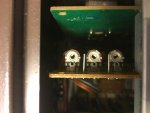illuminations
Member
Hi all,
I've owned a Tuscan 388 for a while. It is still fully functional, but I want to take the leap into adjusting and calibrating the machine. I'm going to start acquiring the necessary items, but had a few questions first. Quick note, I'm pretty new to this so I'll be learning as I go.
I've adjusted the tension arms a few times in the past - most recently the right arm when I was getting extremely slow playback. I noticed this most recent time the adjustment trim pot for the right tension arm would no longer turn clockwise, like it was turned as far is it would go. Is there a way to adjust this? Is it simply a matter of contact cleaner, or does it need to be replaced?
Secondly, I would like to adjust the VU meters. But I'm wondering how this will affect the tapes I've already recorded on the machine.
Lastly, is this a decent multimeter for the general tape maintenance purposes? I've found one used locally.
https://simpsonelectric.com/images/File/datasheets/2608.pdf
I know there's a bunch here.
Thanks in advance.
I've owned a Tuscan 388 for a while. It is still fully functional, but I want to take the leap into adjusting and calibrating the machine. I'm going to start acquiring the necessary items, but had a few questions first. Quick note, I'm pretty new to this so I'll be learning as I go.
I've adjusted the tension arms a few times in the past - most recently the right arm when I was getting extremely slow playback. I noticed this most recent time the adjustment trim pot for the right tension arm would no longer turn clockwise, like it was turned as far is it would go. Is there a way to adjust this? Is it simply a matter of contact cleaner, or does it need to be replaced?
Secondly, I would like to adjust the VU meters. But I'm wondering how this will affect the tapes I've already recorded on the machine.
Lastly, is this a decent multimeter for the general tape maintenance purposes? I've found one used locally.
https://simpsonelectric.com/images/File/datasheets/2608.pdf
I know there's a bunch here.
Thanks in advance.

 Throw up some links and maybe I’ll better understand what quandry is.
Throw up some links and maybe I’ll better understand what quandry is. 